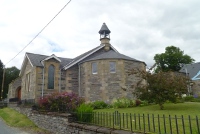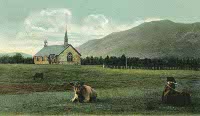7. St Bride's Church
Until 1895 church services were only held in Newtonmore once a month. On most Sundays residents and summer visitors had to travel to Kingussie to worship in the Church of Scotland or the Free Church.

As Newtonmore developed, residents and visitors felt the village should have its own church and after a petition to the Presbytery, St Columba’s Church was built in Station Road. It was designed by the Kingussie architect Alexander Mackenzie.

In 1929 the union of the United Free Church of Scotland with the established church resulted in Newtonmore having two Church of Scotland buildings – St Columba’s and the former UF church, St Andrew’s.

In 1955 it was decided to combine both congregations in a new building in the centre of the village on the site of St Andrew’s Church. The existing building was remodelled and effectively turned around so that its entrance changed from Church Terrace to Glen Road. St Columba’s Church was demolished and stone and stained glass windows from both buildings used in the new church, which opened in 1958. It is dedicated to St Bride – a Celtic saint who has been associated with Newtonmore since the 6th century – see Banchor Cemetery.
The impressive stained glass windows in St Bride’s include one on the theme of Charity, which is dedicated to the memory of Lydia Julia Brewster Macpherson, the widow of the local landowner Macpherson of Balavil. Mrs Macpherson was a generous benefactor to the village. After her husband’s death she lived in the Dower House.
The painting The Cross Stands Empty to the Sky is the work of local artist Jean Noble.

The church welcomes visitors; the normal opening hours are 10-4.

Sources
R. Noble, A Short History of St Bride’s Church: read more
Badenoch Record
Inverness Courier